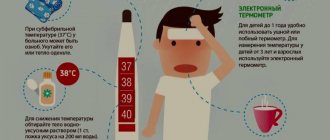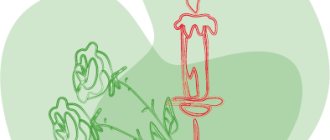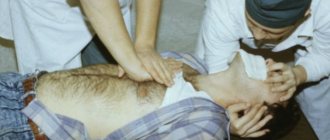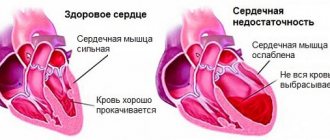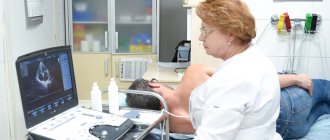Increased intracranial pressure in a child (arterial hypertension, intracranial hypertension) is a common disorder that can be a sign of various diseases. Intracranial pressure increases with brain tumors, hydrocephalus, neuroinfections (meningitis, encephalitis), intracerebral effusions, traumatic brain injuries, some hereditary pathologies and other diseases.
The development of arterial hypertension in a child is especially dangerous. Unstable pressure readings can cause serious abnormalities in brain development: mental retardation, blindness, paralysis and other pathological conditions.
Increased intracranial pressure is not always a sign of disorders. It can increase with everyday activities: defecation, coughing, stressful situations, suckling at the mother's breast, lifting heavy objects. It is not dangerous for the child. If intracranial pressure increases regularly and is permanent, parents and their child should seek medical help.
What is the essence of increased intracranial pressure?
The brain is washed externally and internally by cerebrospinal fluid (CSF). It nourishes, washes and protects brain structures from mechanical influences, maintains optimal intracranial pressure, and also regulates metabolic processes between blood and brain.
Liquor constantly circulates in the ventricles of the brain, inside the skull and other spaces of the spinal cord and brain. In certain areas, liquid accumulates, flows out and, having been distributed over other spaces, is absorbed back. There is a certain balance between the absorption and release of cerebrospinal fluid. If more fluid is released than is absorbed or less is absorbed than is released, or there are obstacles to the outflow of cerebrospinal fluid, the fluid begins to accumulate in a certain place, which causes intracranial pressure.
Since the brain is located in a closed cavity of the skull, the accumulated fluid begins to compress the brain, causing an increase in pressure. In this case, the child may experience episodic attacks of headaches.
Intracranial hypertension is not a rare case in infants. The cause of hypertension in a child from birth can be an intrauterine infection or hypoxia, neuroinfection, birth trauma, congenital defects or prematurity. Such children grow up with elevated levels of hypertension from an early age and get used to them, so they do not complain of headaches. The child may experience excessive excitability, lack of concentration and slow formation of certain mental functions (speech, walking, memory, writing, counting, logic, phonemic hearing). Therefore, if any disturbances in the functioning of the nervous system are detected, you should consult a doctor and undergo the necessary examinations.
Prolonged exposure of the brain to cerebrospinal fluid leads to its reduction. At the same time, the number of liquid cavities increases. This condition is called hydrocephalus. It is accompanied by partial replacement of brain matter with cerebrospinal fluid. In severe clinical cases, newborns experience a disruption in the development of nervous system functions and develop cerebral palsy (cerebral palsy). Severe hydrocephalus is treated with a brain shunt. In most cases, using osteopathic techniques, it is possible to get rid of this disease without surgery.
Signs of increased intracranial pressure in older children
In a child of an older age category, arterial hypertension is manifested by the following symptoms:
- Nausea, vomiting. Occurs against the background of irritation of the membranes of the medulla oblongata. The difference between vomiting in hypertension and vomiting in poisoning is that it does not bring relief.
- Pain behind the eyeballs. They are formed due to the effect of cerebrospinal fluid on the orbital area.
- The appearance of ribbons, flashes, double vision. This occurs as a result of irritation of the optic nerves.
- Attacks of headaches that get worse in the evening and at night.
- Restless sleep, irritability, tearfulness.
Why is unstable intracranial pressure dangerous?
The lack of appropriate treatment for hypertension can provoke the appearance of epileptic seizures and the death of certain parts of the brain due to oxygen deficiency. Chronic increased intracranial pressure, even with minor fluctuations from the norm, negatively affects the activity of the central nervous system. At the same time, signs of nervous exhaustion develop quite quickly, such as sleep disturbance, irritability, fatigue, as well as a decrease in intellectual and physical activity.
The greatest danger with unstable pressure is congestion in the optic discs, which can cause atrophy of nerve tissue, a sharp drop in vision and even complete uncorrectable blindness.
High blood pressure in young children: symptoms of the disease
Increased intracranial pressure can be manifested by the following pathological disorders and symptoms:
- Severe crying, restlessness. A distinctive feature of unstable intracranial pressure is that throughout the day the child may feel well and be relatively calm. In the evening and at night the baby begins to cry and becomes restless. This is due to the anatomy of the cerebrospinal fluid and venous systems. The baby lies down more at night and in the evening. As a result, venous outflow slows down, and the veins of the skull and brain become congested. As a result, the volume of cerebrospinal fluid increases, which provokes the development of arterial hypertension.
- Difficulty falling asleep, frequent waking up, sleep disturbance. The listed symptoms are also due to the structure of the venous and cerebrospinal fluid systems.
- Nausea, attacks of vomiting, profuse, frequent regurgitation. These clinical manifestations are reflex. High intracranial exposure provokes irritation of the membranes of the medulla oblongata, which is responsible for nausea and vomiting. It should be borne in mind that frequent regurgitation in a child can be caused by swallowing air during feeding and overfeeding. Therefore, it is not recommended to draw conclusions about intracranial hypertension based on symptoms alone. However, this pathology cannot be excluded either.
- Increase in head volume. The accumulation of cerebrospinal fluid in the cerebrospinal spaces can lead to divergence of the sutures of the cranial bones, enlargement of the frontal part of the skull, enlargement of the fontanelles and disproportionate size of the head.
- The appearance of a venous network under the scalp. With hypertension, excessive filling and stagnation of blood occurs in the venous network. This provokes expansion of the saphenous veins, which makes them visually noticeable.
- Graefe's symptom. It manifests itself as a dysfunction of the oculomotor nerves, which occurs against the background of birth trauma or high blood pressure. The eyeballs periodically begin to deviate downward, and the sclera becomes visible between the upper eyelid and the edge of the iris.
- Refusal to feed. In infants, intracranial pressure physiologically increases, which leads to increased pain. The result of refusal to feed a child is a lack of weight gain.
Disturbances in psycho-emotional and physical development. This can be caused by insufficient feeding and the presence of damaging factors on the brain.
Treatment of increased intracranial pressure with osteopathy
Living with hypertension for a child is unpleasant and harmful to health.
Under the influence of increased compression, brain structures cannot function normally. This causes atrophy of the white brain fluid, followed by a decrease in intellectual abilities and dysregulation of internal organs. To avoid the above complications, treatment of hypertension should begin as early as possible. To alleviate the child’s condition and normalize intracranial pressure, it is important to restore the balance between the absorption and production of cerebrospinal fluid. Traditional medicine uses diuretics for this. Osteopathy treats arterial hypertension in children using safe manual techniques that normalize the level of cerebrospinal fluid without surgery or drug therapy. Osteopathic techniques are aimed at unloading the venous bed of the head and eliminating pinching of blood vessels by the vertebrae.
Severe symptoms
Perhaps the main sign indicating this illness is the child’s restless behavior. The baby cannot sleep, cries all the time and does not even want to eat. He even vomits water.
In children, already at a few months old, external symptoms of increased intraocular pressure can be noticed and identified.
They are manifested by changes in the parameters of the child’s body:
- the head is disproportionately large;
- the frontal area is enlarged;
- the fontanel has signs of swelling;
- veins on the head;
- eyeballs are lowered too far;
- the child has problems gaining weight and slow reaction times;
- there are some developmental deviations;
- Sometimes frequent regurgitation also indicates an increase in IAP.
As your child grows, the symptoms become clearer and more pronounced. Having learned to speak, the child will be able to say that he is in pain, and it will be easier for parents to understand his condition.
Osteopathic approach to the treatment of intracranial pressure in a child
Osteopathic methods in the treatment of arterial hypertension in children are successfully used in cases where high intracranial compression of brain structures is caused by impaired venous blood circulation.
During osteopathic treatment, three mechanisms are simultaneously activated to improve the outflow of blood from the cranial cavity:
- Restoring the patency of venous vessels at the points of their exit from the cranium and in the area of the neurovascular bundle;
- Impact on parts of the nervous autonomic system;
- Normalization of the suction functions of the chest.
Also, the use of these methods makes it possible to achieve effective results in the complex treatment of arterial hypertension in the absence of indications for surgical intervention. In this case, the osteopath uses manual techniques aimed at restoring the craniosacral rhythm.
The course of osteopathic treatment and the number of manual therapy sessions are determined by the doctor, taking into account how old the child is and what symptoms accompany the disease. The positive effect of osteopathy treatment is visible after just a few sessions.
To achieve stable and long-term results in the treatment of increased intracranial pressure, osteopathic techniques are recommended to be combined with other conservative methods (physiotherapy, therapeutic exercises, adherence to eating and drinking regimes).
A special case
Tell me, can cerebral hypoxia during pregnancy or childbirth lead to increased intracranial pressure in the child?
Galina, Perm
— Hypoxia (oxygen starvation. — Ed.) of the brain suffered by a child will not necessarily lead to disorders of the child’s nervous system. At least not as often as this diagnosis is given by pediatricians and neurologists to children under 1 year of age in Russia.
As a rule, increased intracranial pressure is observed with traumatic brain injury, brain tumors, meningitis, and occlusive hydrocephalus.
Prevention
In order to normalize intracranial pressure, preventive measures should be taken.
It is recommended to adhere to the following rules:
- Adhere to the healthy lifestyle your child needs. Feed him in a timely manner and put him back to bed.
- Be sure to ventilate the room from time to time.
- Create a loving atmosphere in your home to give your baby positive emotions.
- Always use breast milk, which contains all the nutrients your baby needs.
To prevent negative consequences from high intracranial pressure, it is necessary to monitor any changes and manifestations in the child’s behavior. At the first suspicion, contact your doctor for advice. If the fears are confirmed, it will be possible to start treatment earlier and avoid unnecessary problems.


